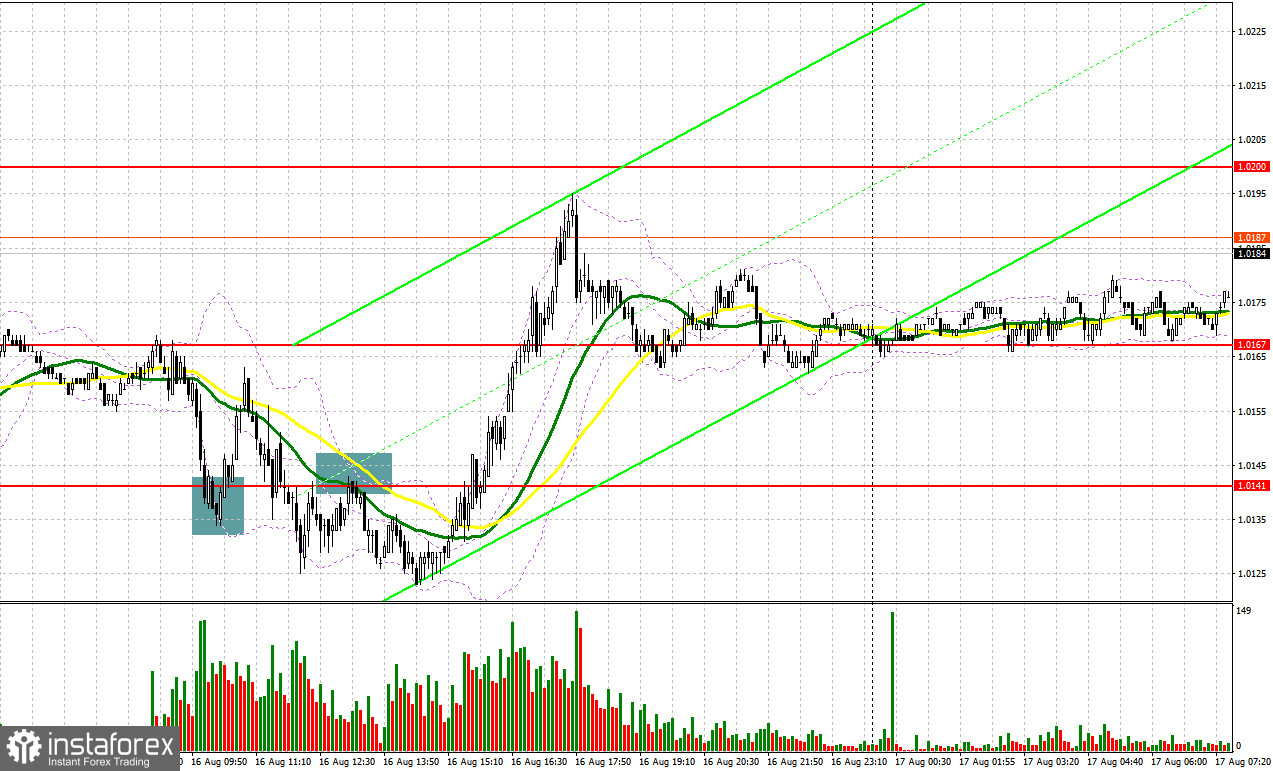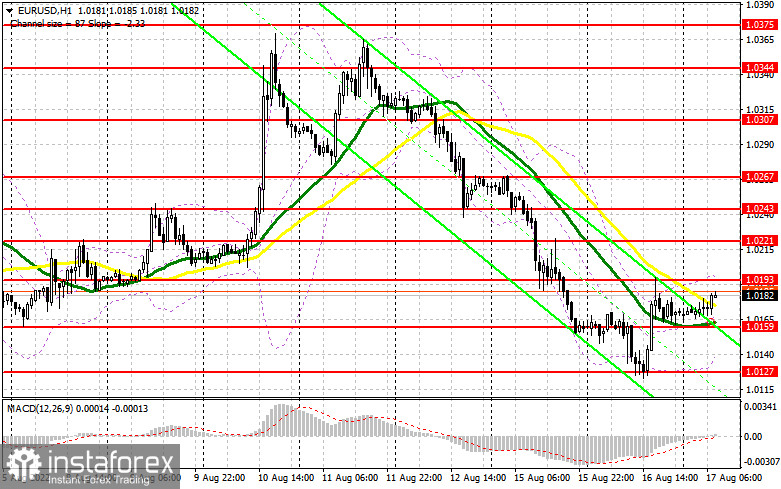Several interesting market entry signals were formed yesterday. Let's take a look at the 5-minute chart and figure out what happened. I paid attention to the 1.0144 level in my morning forecast and advised that you make decisions on entering the market from it. The pair's decline in the area of 1.0144 in the first half of the day after receiving disappointing data on Germany and the eurozone resulted in forming a false breakout and an excellent entry point into long positions. But to my regret, I did not see any active growth from the pair, and after moving up by 20 points, the euro returned to 1.0144. A repeated test of this range took place with a breakdown and a reverse test from the bottom up, which resulted in a sell signal. But even after that, the pair went down only about 15 points, after which the demand for the euro returned as a result of weak data on the US real estate market.

When to go long on EUR/USD:
The euro has every chance for a further upward correction, but much will depend on the statistics that we will see in the first half of the day. Reports are expected on the change in the volume of eurozone GDP for the 2nd quarter of this year, and the change in the level of employment in the eurozone. Clearly, the eurozone economy has fared quite well in the first half of this year, as the energy crisis and high inflation have not yet taken a toll. However, trading is conducted on expectations, not on facts, so even if we receive good indicators, it is unlikely that it would help the euro much. If we see negative data worse than economists' forecasts, the pressure on the pair will return. If EUR/USD falls to the nearest support area of 1.0159, where the average moving averages playing on the bulls' side pass, forming a false breakout at this level will provide the first signal to open long positions in hopes of continuing to build an upward trend with the prospect of a return to 1.0193. A breakthrough and test from top to bottom of this range creates another signal for entering long positions with the possibility of moving up to 1.0221, a breakthrough above which will not be as easy as it seems, since it was from this level that large players sold the euro at the beginning of this week.
If the EUR/USD declines and there are no bulls at 1.0159, the pressure on the pair will increase again. This will open the way to 1.0127, and further support at 1.0099, where I recommend taking profits. A test of this level will bring EUR/USD back into the descending channel observed since August 11. I advise you to buy EUR/USD immediately on a rebound only from 1.0073, or even lower - in the area of 1.0045, counting on an upward correction of 30-35 points within the day.
When to go short on EUR/USD:
The bears' main task is to protect the resistance at 1.0193, formed on the basis of yesterday's results. Weak statistics on the euro area will help to cope with this task, so forming a false breakout there will provide an excellent entry point for selling the euro. An equally important task is to take control of the nearest support at 1.0159, just below which the moving averages go. A breakthrough and consolidation below this range, as well as a reverse test from the bottom up - all this creates another sell signal with the removal of bulls' stops and a larger movement of the pair to the 1.0127 area - this month's low, a retest of which will erase all of the bulls' hopes for building an upward corrections. Consolidating below 1.0127 is a direct road to 1.0099, where I recommend completely leaving short positions. A more distant target will be the area of 1.0073.
If EUR/USD moves up during the European session, as well as the absence of bears at 1.0193, it will be possible to observe a further upward correction with building the lower border of a new ascending channel. In this case, I advise you to postpone short positions to a new weekly high of 1.0221. Forming a false breakout at 1.0221 will be a new starting point for entering short positions. You can sell EUR/USD immediately for a rebound in the area of 1.0243, or even higher - from 1.0267, counting on a downward correction of 30-35 points.

COT report:
The Commitment of Traders (COT) report for August 9 logged a sharp increase in both short and long positions, but the former turned out to be more, which continues to indicate the gradual end of the bear market and an attempt to find a market bottom after reaching euro parity against the US dollar. Statistics on inflation in the US came out last week, which turned everything upside down. The first slowdown in inflationary pressure in recent times since reaching a peak of 10.0% has brought back demand for risky assets. But, as you can see on the chart, it didn't last long. The risk of deterioration of the situation associated with the recession of the global economy discourages traders and investors from any desire to build up long positions in the euro. There are no important reports this week that can help the euro regain lost ground, so I would recommend betting more on trading on the horizontal channel. Definitely, before the fall of this year, we can hardly expect serious market shocks. The COT report shows that long non-commercial positions rose by 8,396 to 200,088, while short non-commercial positions jumped by 4,121 to 234,624. At the end of the week, the overall non-commercial net position remained negative, but slightly increased from -39,811 to -34,536, which indicates a continuation of the market turning towards euro bulls. The weekly closing price increased and amounted to 1.0233 against 1.0206.

Indicator signals:
Moving averages
Trading is above the 30 and 50-day moving averages, which indicates the euro's succeeding growth.
Note: The period and prices of moving averages are considered by the author on the H1 hourly chart and differs from the general definition of the classic daily moving averages on the daily D1 chart.
Bollinger Bands
In case of a decline, the lower border of the indicator around 1.0140 will act as support. In case of growth, the upper border of the indicator in the area of 1.0193 will act as resistance.
Description of indicators
- Moving average (moving average, determines the current trend by smoothing out volatility and noise). Period 50. It is marked in yellow on the chart.
- Moving average (moving average, determines the current trend by smoothing out volatility and noise). Period 30. It is marked in green on the chart.
- MACD indicator (Moving Average Convergence/Divergence — convergence/divergence of moving averages) Quick EMA period 12. Slow EMA period to 26. SMA period 9
- Bollinger Bands (Bollinger Bands). Period 20
- Non-commercial speculative traders, such as individual traders, hedge funds, and large institutions that use the futures market for speculative purposes and meet certain requirements.
- Long non-commercial positions represent the total long open position of non-commercial traders.
- Short non-commercial positions represent the total short open position of non-commercial traders.
- Total non-commercial net position is the difference between short and long positions of non-commercial traders.





















